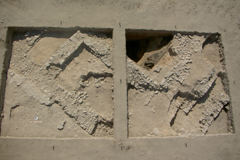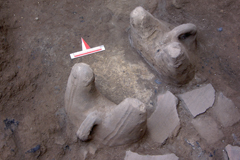- Excavation and General Survey in Turkey >
- Yassıhöyük>
- Excavations in 2009
Yassıhöyük Excavations in 2009
Masako Omura JIAA

Condition of the site at the end of the excavations in 2009.
From 11th September to 9th October in 2009, the first excavation season at Yassıhöyük was carried out. The digging started in two 10m x 10m grids (E8/f9, E8/f10) at the top of the site where architectural remains had been detected during the geomagnetic survey in 2007 and 2008.
In these two grids, four building levels were observed. As a part of the large architectural remain, which was supposed to have occupied a large area of the site, a stone wall was observed and labeled as the 3rd building level. This stone wall is 130cm wide. Approximately 30cm wide stones were placed in shallow ditches made along the same width of the wall, and smaller stones were packed inside of the ditches to adjust the height of the wall. Large block stones were piled on these smaller stones: small stones were also observed between large ones to pack up the spaces. Walls with the same structure have been found in the IIa Stratum at Kaman-Kalehöyük. This large architectural remain was destroyed by a half-basement style architectural remains, which belong to the 1st and 2nd building levels. It is judged from the pottery shards and other artifacts excavated, the 1st, 2nd and 3rd building levels are of the 1st millennium B.C. or the Iron Age.
All the architectural remains from the Iron Age mentioned above were built on the flattened burnt layer. When the flattened burnt layer were begun to be detected right under the wall of the 3rd building level, the top part of the sun-dried brick wall appeared. The plan of this sun-dried brick wall coincides with the plan of the large architectural remain which was detected by the geomagnetic survey. This fact indicates that the magnetic survey detected the architectural remains consisted of sun-dried brick walls in the burnt layer underneath rather than the stone-walls in the upper layer.

A pair of andirons or horned supports.
The actual excavation survey into the burnt layer will start next year. In this year, in order to obtain a guideline for the research in following years, a part of the room R8, which was surrounded by sun-dried brick walls W19 and W20 in the 4th building level, was excavated. It was revealed that the front surface of these walls was covered with thick mud and plaster, and 230cm height of the original walls still remain. Inside the room burnt soil mixed with fallen and broken sun-dried bricks, and carbonated timbers, which were supposed to have been the upper structure of the building were observed. In addition, on the floor covered with black ash, a pair of andirons or horned supports in a characteristic shape was found. Most of the pottery shards excavated were small, however among these, red slipped and polished pottery shards were something to be mentioned. They were thought to belong to the first half of the 2nd millennium B.C., specifically to the Assyria Colonial Period. Considering handmade pottery shards made of clay mixed with plant fibers, it is also possible to infer that these pottery shards have influence of the 3rd millennium B.C.
The 1st of excavations at Yasshöyük was conducted with the aid of Grants-in-Aids for Scientific Research (B) from the Japan Society for the Promotion of Science.